theater,
theatre, theatrical, drama - Theater (American spelling) or theatre (British
spelling) is a building, room, or other setting in which theatrical
performances or cinematic shows
can be presented. Theater is also the art of writing and producing
plays. This is the branch of the performing arts concerned with
acting out stories in front of an audience
using combinations of speech, gesture,
music, dance,
sound and spectacle -- indeed any one or more elements of the
other performing arts. In addition to the standard narrative presentation
of dialog and action, theater takes such forms as opera, ballet,
pantomime, bunraku, and
kabuki.
The history of the theater in Western tradition generally begins with Greek drama. The words "theater" and "theory" both have their origins in the Greek word theatron, "a place for seeing, especially for dramatic presentations," and from theasthai, "to gaze at, contemplate, view as spectators, as in a theater," To theorize, to think about the meaning of life and the state of contemporary culture is thus not far from the means to viewing enactments of it.
Drama is the branch of theater in which speech, either as written or as improvised, is most important.
"Theatrical," having to do with public performances of plays, can also suggest the means intended to attract attention, as if acting in a play. (See flamboyant and flourish.)
The people who often collaborate to make theatrical productions are typically:
and the production team:
The designs of theater spaces can be of various kinds. Each a stage or playing space, an area for the audience, and off-stage (or back-stage) areas for preparation and storage. Theaters in ancient Greece were semicircular, the audience sitting on tiers of seats arrayed above a "raked" or sloping stage -- the back of the stage being higher than in the front. Other types of theaters include proscenium, thrust, in the round (akin to arena or amphitheater), cinema, and puppet theater.
Just as verisimilitude -- the creation of illusions -- is important in most of the visual arts, it is essential in theater. Typically actors pretend that they are not aware of the audience in order to produce and to maintain their transformation. One theatrical convention that enforces this is the maintenance of a "fourth wall" -- an imaginary barrier at the edge of the stage through which the audience watches a performance.
(pr. thee'eh-tr)
Examples of artworks related to theater:
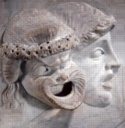
Roman, A Comic and a Tragic Theater Mask, 2nd
century CE,
marble relief, British
Museum, London. On the left, the comic mask, represented
in three-quarter view,
is bearded, its crowning wreath of ferula (giant fennel) an attribute associated with
Bacchus, the Roman god of theater (Greek equivalent Dionysos).
On the right, the mask of a tragic character is carved in lower relief. In ancient
Greece and Rome, every theater mask covered an actor's face entirely,
making a large opening for the mouth necessary to allow the audience
to hear the actor's voice. Each mask's facial features conveyed
an exaggerated expression,
compensating for the fact that the audience
 couldn't
see the actor's own expressions. In the fifth century BCE,
standard mask forms became common for specific roles, with the
specific features of each reflecting the character of the figure
being played.
couldn't
see the actor's own expressions. In the fifth century BCE,
standard mask forms became common for specific roles, with the
specific features of each reflecting the character of the figure
being played.
A contemporary interpretation of masks symbolizing comedy and tragedy.
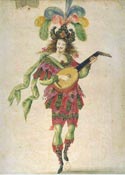
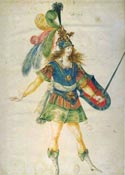

French, Lute Player, the Warrior, and Apollo, drawings of costumes for the Ballet royal de
la nuit (Royal Ballet of the Night), c. 1650, Bibliotheque
Nationale France, Paris. The ballet ends with the appearance
of Aurore, who yields her place to the rising sun -- Apollo --
played the premiere performance by the young King Louis XIV --
popularly known ever since as "The Sun King." See Baroque, dance.
![]()
Torii Kiyonobu I (Japanese, c. 1664-1729),
Sawamura Kodenji as Tsuyu no Mae, 1698,
hand-colored woodblock
print; signature: Wagako Torii
Shobei; seal: Kiyonobu;
publisher: Hangiya hammoto, Worcester Art Museum, MA. Torii Kiyonobu
I was the founder of the "Torii school", which specialized
in depictions of the Kabuki theater. See Japanese art and ukiyo-e.
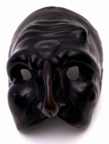
Italian, Mask of Pulcinella, c. 1700, molded leather mask from a Commedia dell'arte theater troupe, The Theatre Museum, London. Pulcinella was traditionally a stupid servant, recognisable from his big beaky nose, hunchback and the wart on his forehead. As the 17th century progressed, the role of Pulcinella became more interesting and more diverse.
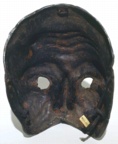 By the time this mask was made, he was not necessarily a servant, but might be a peasant, a dentist, a physician, a painter or a soldier. The mask also changed. Whereas earlier versions had a mustache and beard hiding most of the actor's face, this is a half-mask. Pulcinella was the figure from whom Punch in Punch and Judy puppet shows was derived.
By the time this mask was made, he was not necessarily a servant, but might be a peasant, a dentist, a physician, a painter or a soldier. The mask also changed. Whereas earlier versions had a mustache and beard hiding most of the actor's face, this is a half-mask. Pulcinella was the figure from whom Punch in Punch and Judy puppet shows was derived. Here is a view of the back side of the mask.
French, about 1750, Théâtre de l'univers (Theater of the Universe), a portable camera obscura built into a folio binding stamped Théâtre de l'univers, made with wood, metal, and glass; open: 22 1/8 x 21 3/4 x 14 3/8 inches; Getty Research Institute, Werner Nekes Collection, Malibu, CA.

Toshusai Sharaku (Japanese), The
Two Actors Sanogawa Ichimatsu III and Ichikawa Tomiemon,
1774, Museum für Ostasiatische Kunst, Berlin. See Japanese art and portrait.
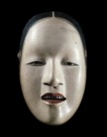
Japan, Nô mask of a young woman, 18th-19th
century, carved and painted wooden
mask, the white
paint composed of crushed egg-shells in a binder,
British Museum, London. Nô (also called Noh) is the classical
drama of Japan, with music and dance performed in a highly stylized
manner by masked and elaborately dressed performers on an almost
bare stage. The museum says, "Present-day Japanese Nô
performances adhere to the traditions
established in the fourteenth and early fifteenth centuries by
the masters Kan'ami (1333-84) and his son Zeami (1363?-1443?).
A number of standard masks are used in different dramas. A skilfully
carved mask will appear to have subtle changes of expression
depending on the way in which the wearer turns his head and the
angle at which it is held.
This is one of several variations of a young-woman mask based
on an original design by Zeami, known as Zô-onna.
The false eyebrows painted high on the forehead and the blackened
teeth were fashionable
cosmetic styles
for over a thousand years until the late nineteenth century."
See Japanese
art.
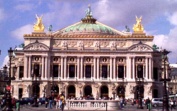
Charles Garnier (French, 1825-1898), Paris Opéra,
1861-74. This beaux-arts
pile is emblematic of
late pre-modern public architecture.
The façade
is entered through an arcade
of portals beneath two sizes
of gracefully paired columns.
The flanking pavilions are crowned with segmental pediments.
Under the entablature
are circular windows and portrait busts.
 Above is an attic
storey decorated with festoons and gilded
masks.
Above is an attic
storey decorated with festoons and gilded
masks.
Above this is a broad, low dome
over the the
auditorium.
The sumptuous foyer, with its escalier d'honneur (staircase) (a section view rendered
by Garnier) are consistent
with the Neo-Baroque
exterior, in that each is opulent to a degree not seen again
until the building of American casinos in the late 20th century.
See façade.

John Singer Sargent (American, 1856-1925),
Ellen Terry as Lady Macbeth, 1889, oil on canvas,
221.0 x 114.3 cm, Tate Gallery, London. See portrait.

Georges-Pierre Seurat (French, 1859-1891),
Circus Sideshow (La Parade), 1887-88,
oil on canvas,
39 1/4 x 59 inches (99.7 x 149.9 cm), Metropolitan Museum of
Art, NY. (On the Met's page, you can enlarge any detail.) This
painting depicts the effects of gas lights illuminating the free
entertainment offered at the entrance of a traveling theater.
This "sideshow" was intended to attract a crowd and
encourage the sale of tickets. See neo-impressionism
and pointillism.

Henri de Toulouse-Lautrec (French, 1864-1901),
Madame Thadée Natanson (Misia Godebska,
1872-1950) at the Theater, 1895, gouache on cardboard,
24 1/2 x 29 1/2 inches (62.2 x 74.9 cm), Metropolitan Museum
of Art, NY. See contour lines
and Post-Impressionism.

Salvador Dalí (Spanish, 1904-1989; active in Paris and New York), Retrospective Bust of a Woman (Buste de femme rétrospectif), 1933, some elements reconstructed 1970, painted porcelain, bread, corn, feathers, paint on paper, 29 x 27 1/4 x 12 5/8 inches (73.9 x 69.2 x 32 cm), Museum of Modern Art, NY. See Surrealism.

Jørn Utzon (Danish, 1918-), Sydney
Opera House, 1957-1973, Australia. See more photographs of the opera house.
Also see arts advocacy, animation, art center or arts center, auditory, automaton, balcony, bunraku, entertainment, Fluxus, four-dimensional, gallery, interdisciplinary, kinesthetic, kinetic, magic lantern, marionette, mask, memorabilia, modernism, muses, Nabis, narrative art, performance art, permanence, popular culture, postmodernism, puppet, puppetry, Realism, storerooms, theory, universal artwork, video, viewer, virtual reality, and voyeurism.
https://inform.quest/_art